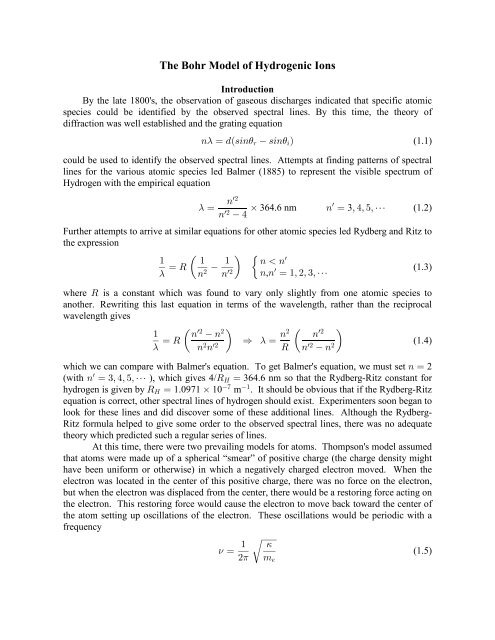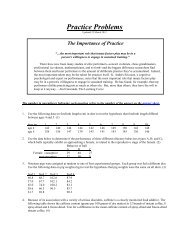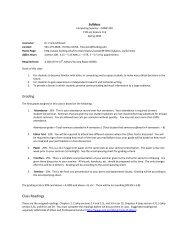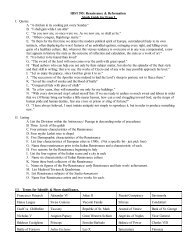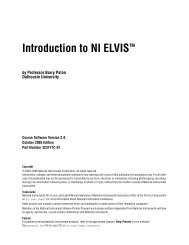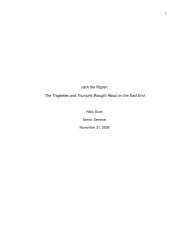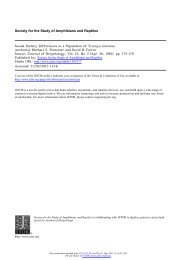The Bohr Model of Hydrogenic Ions
The Bohr Model of Hydrogenic Ions
The Bohr Model of Hydrogenic Ions
Create successful ePaper yourself
Turn your PDF publications into a flip-book with our unique Google optimized e-Paper software.
<strong>The</strong> <strong>Bohr</strong> <strong>Model</strong> <strong>of</strong> <strong>Hydrogenic</strong> <strong>Ions</strong><br />
Introduction<br />
By the late 1800's, the observation <strong>of</strong> gaseous discharges indicated that specific atomic<br />
species could be identified by the observed spectral lines. By this time, the theory <strong>of</strong><br />
diffraction was well established and the grating equation<br />
8- œ .Ð=38) < =38)<br />
3 Ñ<br />
(1.1)<br />
could be used to identify the observed spectral lines. Attempts at finding patterns <strong>of</strong> spectral<br />
lines for the various atomic species led Balmer (1885) to represent the visible spectrum <strong>of</strong><br />
Hydrogen with the empirical equation<br />
w#<br />
8<br />
w<br />
- œ ‚ 364.6 nm 8 œ 3 ß %ß &ß â (1.2)<br />
8w#<br />
%<br />
Further attempts to arrive at similar equations for other atomic species led Rydberg and Ritz to<br />
the expression<br />
" " "<br />
w<br />
8 8<br />
œ V Œ <br />
- 8# 8w#<br />
œ w<br />
8,<br />
8 œ "ß #ß $ß â<br />
where V is a constant which was found to vary only slightly from one atomic species to<br />
another. Rewriting this last equation in terms <strong>of</strong> the wavelength, rather than the reciprocal<br />
wavelength gives<br />
(1.3)<br />
w# # # w#<br />
" 8 8 8 8<br />
œ V Œ Ê - œ<br />
(1.4)<br />
- 8# Π<br />
8w# V 8w# 8#<br />
which we can compare with Balmer's equation. To get Balmer's equation, we must set 8 œ 2<br />
w<br />
(with 8 œ $ß %ß &ß â ), which gives 4/ VL<br />
œ 364.6 nm so that the Rydberg-Ritz constant for<br />
( "<br />
hydrogen is given by VL<br />
œ 1.0971 ‚ 10 m . It should be obvious that if the Rydberg-Ritz<br />
equation is correct, other spectral lines <strong>of</strong> hydrogen should exist. Experimenters soon began to<br />
look for these lines and did discover some <strong>of</strong> these additional lines. Although the Rydberg-<br />
Ritz formula helped to give some order to the observed spectral lines, there was no adequate<br />
theory which predicted such a regular series <strong>of</strong> lines.<br />
At this time, there were two prevailing models for atoms. Thompson's model assumed<br />
that atoms were made up <strong>of</strong> a spherical “smear” <strong>of</strong> positive charge (the charge density might<br />
have been uniform or otherwise) in which a negatively charged electron moved. When the<br />
electron was located in the center <strong>of</strong> this positive charge, there was no force on the electron,<br />
but when the electron was displaced from the center, there would be a restoring force acting on<br />
the electron. This restoring force would cause the electron to move back toward the center <strong>of</strong><br />
the atom setting up oscillations <strong>of</strong> the electron. <strong>The</strong>se oscillations would be periodic with a<br />
frequency<br />
,<br />
/ œ "<br />
# 1 7<br />
Ê<br />
/<br />
(1.5)
<strong>The</strong> <strong>Bohr</strong> Atom 2<br />
where , is an equivalent “spring constant”, and 7 / is the mass <strong>of</strong> the electron. As the electron<br />
oscillated within the atom, the moving electron would radiate electromagnetic energy <strong>of</strong> the<br />
same frequency as the oscillating electron. In addition, the energy loss due to radiation would<br />
eventually bring the electron to rest within the atom, and the “damping” <strong>of</strong> the oscillations due<br />
to the radiation should show up as a broadening <strong>of</strong> the spectral lines. This model does, in fact,<br />
do a very favorable job in predicting line shapes. However, it does not adequately describe<br />
why a single atomic species should exhibit many different spectral lines.<br />
<strong>The</strong> so-called planetary model <strong>of</strong> the atom was based upon the experimental findings <strong>of</strong><br />
Rutherford. Following Becquerel's discovery <strong>of</strong> natural radioactivity in 1896, Rutherford<br />
studied the emissions <strong>of</strong> these radioactive materials. He was able to classify two different<br />
types <strong>of</strong> radiation, α -radiation, and "-radiation. By doing charge-to-mass measurements on<br />
these particles emitted from a radioactive nucleus, he was able to determine that the α particle<br />
was simply a He nucleus. Since these α particles were emitted with a fixed energy, they<br />
proved an ideal tool to probe the atom in an attempt to understand the atomic structure. When<br />
Rutherford and his two graduate students, Geiger and Marsden, began to study the collisions <strong>of</strong><br />
α particles with thin foils, they discovered that most <strong>of</strong> the α particles were not deflected, and<br />
that those that were deflected were deflected by relatively large amounts. (<strong>The</strong> Thompson<br />
model <strong>of</strong> the atom predicted only very small deflections <strong>of</strong> the incoming α particle.) To<br />
explain the very large backscattering <strong>of</strong> the α particles one has to assume that the mass <strong>of</strong> the<br />
"&<br />
atom is concentrated in a very small volume, the radius <strong>of</strong> which is <strong>of</strong> the order <strong>of</strong> 10 m.<br />
Based upon x-ray scattering experiments, where x-rays were scattered from atomic planes<br />
"!<br />
within crystals, the interatomic distance was believed to be <strong>of</strong> the order <strong>of</strong> 10 m. This<br />
meant that the positive charge and most <strong>of</strong> the mass <strong>of</strong> the atom was confined in a very small<br />
“nucleus” and that the rest <strong>of</strong> the atom was essentially empty (small light electrons would have<br />
to swarm about this nucleus to produce an atom). One <strong>of</strong> the fundamental problems <strong>of</strong> this<br />
model is the fact that moving charges should radiate energy. Electrons moving around the<br />
nucleus would, therefore, loose some <strong>of</strong> their energy and would eventually fall into the<br />
nucleus, collapsing the atom!<br />
<strong>The</strong> <strong>Bohr</strong> Atom<br />
In 1913, <strong>Bohr</strong> proposed a model <strong>of</strong> the hydrogen atom which is based upon the planetary<br />
model, and which incorporated some <strong>of</strong> the ideas that had been developed by Planck and<br />
Einstein in the explanation <strong>of</strong> blackbody radiation and the photoelectric effect. He first<br />
assumed that the electron orbits the nucleus (a single proton) in a simple circular path as<br />
shown below.<br />
e<br />
Ze<br />
r
<strong>The</strong> <strong>Bohr</strong> Atom 3<br />
<strong>The</strong> magnitude <strong>of</strong> the electrostatic force <strong>of</strong> attraction between the nucleus and the electron<br />
is given by<br />
J œ 5Ð^/Ñ/<br />
< # (1.6)<br />
where 5 is the Coulomb constant (<strong>of</strong>ten expressed as 1/41% 9 ), < is the distance between the<br />
nucleus and the electron, / is the charge <strong>of</strong> the electron, and ^/ is the charge <strong>of</strong> the nucleus for<br />
a “hydrogenic” ion (any ion with only one electron orbiting the nucleus). This electrostatic<br />
#<br />
force is the centripetal force acting on the electron and must be equal to 7@ Î< , giving<br />
or<br />
5Ð^/Ñ/ 7@<br />
œ<br />
<<br />
#<br />
<<br />
#<br />
7@ œ 5Ð^/Ñ/<br />
<<br />
Thus far, we have not introduced anything which is non-classical in our model. Let's<br />
examine the result <strong>of</strong> assuming that the frequency <strong>of</strong> radiation is just the classical frequency <strong>of</strong><br />
revolution. <strong>The</strong> velocity <strong>of</strong> the electron is related to the “frequency” <strong>of</strong> revolution <strong>of</strong> the<br />
electron by the equation @ œ = < œ # 1 / < , and thus to the frequency <strong>of</strong> radiation emitted from<br />
the atom. From our last equation, we have<br />
or<br />
#<br />
(1.7)<br />
(1.8)<br />
# #<br />
7@ œ 7 # 1/ < œ 5Ð^/Ñ/<br />
(1.9)<br />
<<br />
/ œ " Ê<br />
5^/<br />
# 1 7<<br />
$<br />
#<br />
(1.10)<br />
We want to use this last equation to calculate a numerical value for the frequency / (and thus<br />
the wavelength). To do this, we use some “tricks” to get useful combinations <strong>of</strong> constants and<br />
we let ^ œ 1 for hydrogen and < " A. °<br />
" ( 5/<br />
#)-# " Í (14.4 eV-A) ° -# " (14.4 eV) -#<br />
/ œ œ œ<br />
# 1<br />
Ë<br />
( 7-<br />
#)<br />
<<br />
$<br />
# 1 Ì (511 keV)(1 A) ° $ # 1 Ë<br />
(5.11 ‚ 10<br />
&<br />
eV)(1 A) ° #<br />
from which we obtain<br />
or, since -/ œ -,<br />
"& "<br />
/ œ 2.534 ‚ "! sec<br />
- œ 1183.6 A. °
<strong>The</strong> <strong>Bohr</strong> Atom 4<br />
This value agrees very well with the observed wavelength <strong>of</strong> the Lyman- α line, 1215.7 A, °<br />
indicating that the <strong>Bohr</strong> model may have some validity. But there still remains a thorny<br />
problem. If the electron radiates energy as it moves in its orbit, the electron must loose energy,<br />
and therefore spiral inward toward the nucleus, eventually collapsing. Thus, this picture is not<br />
complete.<br />
In an attempt to circumvent this classical collapse, <strong>Bohr</strong> looked to the findings <strong>of</strong><br />
Einstein and Planck. Since the energy <strong>of</strong> electromagnetic waves seem to come in packets <strong>of</strong><br />
size 2/ , <strong>Bohr</strong> postulated that the energy emitted from an atom must be emitted in dicrete<br />
chunks <strong>of</strong> energy equal to 2/ . Thus, <strong>Bohr</strong> postulated that an electron could exist is some<br />
orbiting state within the atom without radiating, but if the electron were to change from one<br />
stable state to another, the energy change in the atom must be equal to the energy emitted by<br />
the photon, or<br />
I I œ 2<br />
0 3 / (1.11)<br />
To continue this line <strong>of</strong> reasoning, we must look for an expression for the total energy <strong>of</strong><br />
the atom. This is accomplished by combining the kinetic energy <strong>of</strong> the electron and the<br />
electrostatic potential energy <strong>of</strong> the atom. <strong>The</strong> kinetic energy <strong>of</strong> the electron is related to the<br />
electrostatic force by Equation 1.6, from which we can write<br />
<strong>The</strong> electrostatic potential energy <strong>of</strong> the electron is given by<br />
which gives<br />
" 5Ð^/Ñ/<br />
7@ # œ<br />
(1.12)<br />
# # <<br />
Y Ð
<strong>The</strong> <strong>Bohr</strong> Atom 5<br />
<strong>The</strong> total energy <strong>of</strong> the electron in it's orbit around the nucleus is the sum <strong>of</strong> the kinetic<br />
and potential energies<br />
" 5Ð^/Ñ/ 5^/ / " 5^/ /<br />
I œ I538 I:9><br />
œ œ <br />
# < < # <<br />
<strong>Bohr</strong>'s hypothesis, then, leads us to the equation<br />
which can be written<br />
" 5 ^/ / " 5 ^/ /<br />
I0 I3<br />
œ 2 / œ ” <br />
<br />
# < • ” <br />
# <<br />
•<br />
0 3<br />
(1.15)<br />
(1.16)<br />
2- 5Ð^/Ñ/ " "<br />
I0 I3 œ 2/<br />
œ œ ” •<br />
- # <
<strong>The</strong> <strong>Bohr</strong> Atom 6<br />
and we obtain an expression for the radius given by<br />
#<br />
< œ P<br />
5^7/<br />
<strong>Bohr</strong>, using arguments similar to Planck's, postulated that the angular momentum was<br />
quantized and had the form<br />
#<br />
P œ 8h (1.20)<br />
where h œ 2Î# 1, with 2 being Planck's constant. <strong>The</strong> radius <strong>of</strong> a <strong>Bohr</strong> orbital, then, is given<br />
by<br />
# # #<br />
8 h 8<br />
< œ œ +<br />
^57/<br />
# o (1.21)<br />
^<br />
where + o is some constant. <strong>The</strong> relationship for the energy levels <strong>of</strong> an electron within a<br />
hydrogenic atom is now given by<br />
#<br />
o<br />
# #<br />
# #<br />
5 ^/ 7/ I<br />
I8<br />
œ œ <br />
# 8h<br />
8<br />
(1.22)<br />
where Io<br />
is the ground state energy (the state where 8 œ "). This is just the energy that must<br />
be added to the electron in the ground state to ionize the atom, and is, therefore, the ionization<br />
potential energy. For hydrogen, the ionization potential was known to be approximately 13.6<br />
eV. <strong>The</strong> ground state energy for <strong>Bohr</strong>'s model <strong>of</strong> the hydrogen atom (where ^ œ ") is given<br />
by<br />
#<br />
# % # # $<br />
75 / 7- 5/ c&"" ‚ "! eVdc"Þ%% MeV † fmd<br />
Io<br />
œ œ œ œ "$Þ'"<br />
#h#<br />
# #<br />
eV (1.23)<br />
# h- # c"*(Þ$ MeV † fmd<br />
in excellent agreement with the ionization potential for hydrogen. In addition, the radius <strong>of</strong> the<br />
first <strong>Bohr</strong> orbital, the orbit with the lowest (or ground state) energy level is given by<br />
+ œ h #<br />
o<br />
(1.24)<br />
75/<br />
#<br />
Evaluating this to determine the size <strong>of</strong> the first <strong>Bohr</strong> orbit we obtain<br />
# #<br />
h- c"*(Þ$ MeV † fmd<br />
‰<br />
+ o œ œ œ !Þ&#* A (1.25)<br />
7-# 5/<br />
#<br />
c!Þ&"" MeV dc"Þ%%! MeV † fmd<br />
in excellent agreement with the known size <strong>of</strong> atoms.<br />
At this point, we have found the predicted energy levels for <strong>Bohr</strong>'s hypothetical<br />
stationary states, and the corresponding electron orbital radii for these states. Both the<br />
energies and the radii are quantized as expected. In addition, we find that the angular<br />
momentum <strong>of</strong> the electron is also quantized. <strong>The</strong> quantized nature <strong>of</strong> the energy levels is just<br />
what is needed to give the discrete spectrum observed for hydrogen and other atoms. <strong>The</strong><br />
#
<strong>The</strong> <strong>Bohr</strong> Atom 7<br />
predicted wavelengths for these lines can be determined by applying <strong>Bohr</strong>'s equation<br />
2-<br />
2/<br />
œ œ I I<br />
-<br />
0 3<br />
(1.26)<br />
An energy diagram <strong>of</strong> the hydrogen atom is shown below, where the ground state<br />
energy has been assigned zero energy. <strong>The</strong> actual total energy <strong>of</strong> an electron which is bound to<br />
the hydrogen atom is negative and the allowed energies are given by<br />
I œ I o<br />
8<br />
8#<br />
(1.27)<br />
which gives the ground state energy equal to "$Þ' eV, the next higher energy level as $Þ%<br />
eV, and the energy <strong>of</strong> a free electron as zero. In the diagram below, we have simply shifted the<br />
energy levels upward by an amount equal to the ground state energy. This allows us to plot the<br />
energy <strong>of</strong> each successive level relative to the ground state. <strong>The</strong> second energy level is<br />
indicated as 10.2 eV above the ground state. Also indicated on this energy level diagram is the<br />
wavelength <strong>of</strong> a photon emitted when an electron changes from one energy level to another.<br />
<strong>The</strong> lines shown on this diagram are the Lyman series which occur in the ultraviolet region <strong>of</strong><br />
the spectrum. <strong>The</strong> linear spacing between the verticle lines is proportional to the actual<br />
wavelengths <strong>of</strong> the emitted line. You can see that the wavelengths <strong>of</strong> the emitted photons get<br />
closer and closer at the low wavelength limit and eventually “pile up” at the low wavelength<br />
limit, which is given by<br />
or<br />
2-<br />
2/<br />
œ œ "$Þ' eV (1.28)<br />
-<br />
- œ *""Þ) ‰ A (1.29)<br />
<strong>The</strong> next diagram shows some <strong>of</strong> the possible transitions that can arise when an electron<br />
moves from one energy level to another (not just the ground state energy level). It turns out<br />
that only certain types <strong>of</strong> transitions are allowed! This gives rise to so-called selection rules<br />
for electonic transitions, and further restricts the possible wavelengths that can be observed<br />
from a given atomic species.<br />
Note: One can show that the energy levels <strong>of</strong> an electron withing a hydrogenic atom are<br />
related to the square <strong>of</strong> the angular momentum using the following “trick”. If we square the<br />
first term <strong>of</strong> the equation<br />
and divide by<br />
#<br />
7@ Î# , we have<br />
#<br />
" 5^/ / 7@<br />
I œ œ œ IoÎ8<br />
# < #<br />
#<br />
# # # # # # #<br />
# 5 ^/ / 7@ 5 ^/ /<br />
I œ I ƒ I œ ƒ œ <br />
%
<strong>The</strong> <strong>Bohr</strong> Atom 8<br />
which can be written<br />
I œ <br />
# # # # # #<br />
5 ^/ 7/ 5 ^/ 7/<br />
#<br />
œ <br />
# 7@< #P#<br />
<br />
(1.31)<br />
where P is the angular momentum. This demonstrates that the total energy <strong>of</strong> the electron is<br />
inversely proportional to the square <strong>of</strong> the angular momentum. This fact may have led <strong>Bohr</strong> to<br />
postulate that the angular momentum <strong>of</strong> the electron within the atom was quantized, giving<br />
7@< œ P œ 8-98=>+8><br />
<br />
14<br />
Hydrogen Atom Energy Level Diagram<br />
12<br />
10<br />
Energy (eV)<br />
8<br />
6<br />
972.53<br />
949.74<br />
4<br />
1025.72<br />
2<br />
1215.66<br />
0<br />
Wavelengths
<strong>The</strong> <strong>Bohr</strong> Atom 9<br />
n=4<br />
n=3<br />
Paschen<br />
n=2<br />
Balmer<br />
n=1<br />
Lyman
<strong>The</strong> <strong>Bohr</strong> Atom 10<br />
Summary <strong>of</strong> Equations for <strong>Bohr</strong>'s <strong>Model</strong><br />
<strong>of</strong> <strong>Hydrogenic</strong> Atoms<br />
<strong>The</strong> energy <strong>of</strong> the bound electron is given by:<br />
# Io<br />
7- 5/<br />
<br />
I8<br />
œ ^ where I œ œ "$Þ'"<br />
8<br />
#<br />
o<br />
#<br />
eV<br />
# h-<br />
<strong>The</strong> radii <strong>of</strong> the electron orbitals are given by:<br />
# # #<br />
# + o<br />
h-<br />
‰<br />
< 8 œ 8 where + o œ œ !Þ&#* A<br />
^ 7-# 5/<br />
#<br />
<strong>The</strong> energy carried away by a photon as an electron drops from a higher energy state to a lower<br />
energy state is given by:<br />
2- # # " "<br />
2/<br />
œ œ I0 I3<br />
œ ^ I <br />
-<br />
o 8 8 Ÿ<br />
#<br />
# #<br />
0 3<br />
From this last equation we can determine the possible wavelengths which can be emitted from<br />
the atom:<br />
# #<br />
" " " ^ I<br />
œ VD<br />
V œ<br />
- D<br />
8# 8# Ÿ where o<br />
3 2-<br />
0
<strong>The</strong> <strong>Bohr</strong> Atom 11<br />
Corrections to the <strong>Bohr</strong> <strong>Model</strong><br />
In deriving the <strong>Bohr</strong> model <strong>of</strong> a hydrogenic atom (or ion), we assumed that the electron<br />
orbited a fixed nucleus. In order to correct for that assumption, we need to look at the situation<br />
where both the nucleus and the electron can move (i.e., both particles have kinetic energy).<br />
Let us assume that the distance between the nucleus and the electron is fixed at some distance<br />
<strong>The</strong> <strong>Bohr</strong> Atom 12<br />
This means we can express the kinetic energy equation as<br />
#<br />
# # # # #<br />
OI œ " ˆ QV 7V ‰ œ " QV 7 Q<br />
" # = V<br />
# # " Π" <br />
7 =<br />
" Q<br />
œ ŒQ V<br />
# 7<br />
#<br />
" # =<br />
#<br />
(1.36)<br />
which can also be written in terms <strong>of</strong> the distance between the proton and electron as<br />
or<br />
# #<br />
" Q " 7Q Q 7<br />
OI œ ŒQ V" # = # œ Œ Œ V<br />
# = # (1.37)<br />
# 7 # 7 Q 7<br />
#<br />
" 7 Q 7 # # " 7Q # # " # #<br />
OI œ Œ Œ QV = œ Œ V = œ . V = (1.38)<br />
# 7 Q 7 # Q 7 #<br />
where . is the reduced mass <strong>of</strong> the system. This is the same expression for the kinetic energy<br />
that would arise from a single particle <strong>of</strong> mass . moving is a circle <strong>of</strong> radius V with a velocity<br />
given by @ œ = V. Thus, we can correct for the motion <strong>of</strong> the nucleus simply by using the<br />
reduced mass . in place <strong>of</strong> the mass <strong>of</strong> the electron.<br />
This would imply (because our results for the hydrogen atom seem to work so well)<br />
that the reduced mass must be approximately equal to the mass <strong>of</strong> the electron. Let's express<br />
the reduced mass in terms <strong>of</strong> the ratio <strong>of</strong> the mass <strong>of</strong> the electron to the mass <strong>of</strong> the nucleus as<br />
seen in the next equation.<br />
7Q 7 7/<br />
. œ œ œ<br />
Q 7 " 7- #<br />
" !Þ!!!&%<br />
Q-<br />
#<br />
#<br />
(1.39)<br />
If the mass <strong>of</strong> the electron is very small relative to the mass <strong>of</strong> the nucleus, then the term<br />
7ÎQ in the denominator can be eccentially ignored. In fact, the proton rest mass energy is<br />
approximately 2000 times larger than the rest mass energy <strong>of</strong> the electron, so that the reduced<br />
mass is very nearly equal to the mass <strong>of</strong> the electron (only about 0.05% smaller). This does<br />
give a slightly different value for the energies, wavelengths, and radii <strong>of</strong> the Hydrogen atom<br />
than what we obtained earlier. <strong>The</strong> corrected ground state energyß<br />
for example, is given by<br />
I œ "$Þ'! /Z<br />
! -9


